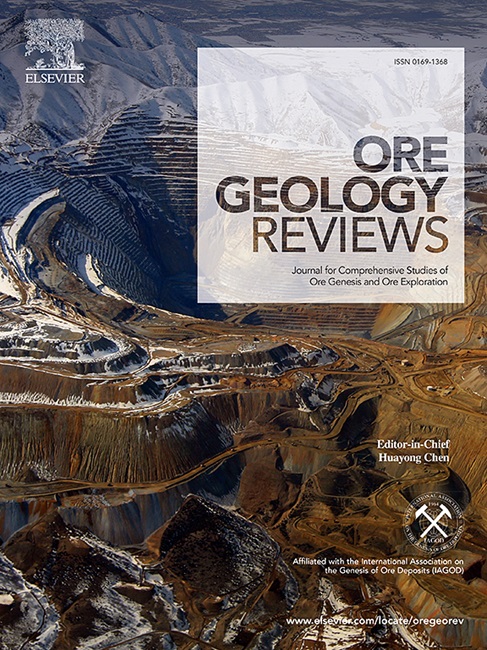Fe, Mg, Sr-Nd-Pb, C-O isotopes and geochemical constraints on the genesis of Bayan Obo Fe-REE-Nb deposit, Inner Mongolia, Northern China
IF 3.2
2区 地球科学
Q1 GEOLOGY
引用次数: 0
Abstract
Bayan Obo is one of the largest iron ore deposits in China and holds the world’s largest resources of rare earth elements (REE). The enrichment mechanisms of ore-forming elements and the metallogenic model of the deposit have been the focus of extensive research. Various carbonatites in the deposit are complex in composition and contain a notable amount of REE-bearing minerals, making them among the most favorable hosts for REE-rich ores globally. The carbonatites at Bayan Obo follow an evolutionary sequence from iron-rich to magnesium-rich and finally to calcium-rich types, with iron-rare-earth ores primarily hosted in dolomitic and siderite carbonatites. In this study, we reveal the genesis of the Bayan Obo deposit by examining siderite carbonatites using Fe-Mg, Sr-Nd-Pb and C-O isotopes, as well as whole-rock major and trace geochemical analyses. The results show that the Fe isotopic variation in the siderite carbonatites is narrow, with δ56Fe ranging from −0.33 ‰ to −0.08 ‰. The δ26Mg values range from −1.31 ‰ to −0.09 ‰, indicating a mantle source. The εNd(t) values and initial 87Sr/86Sr ratios of the siderite carbonatites are concentrated between −0.72 to 1.65 and 0.702869 to 0.704619, respectively. The Pb isotopic compositions exhibit comparable 206Pb/204Pb and 207Pb/204Pb ratios (15.992 to 16.482 and 15.271 to 15.412, respectively), but variable 208Pb/204Pb ratios (36.701 to 51.566). The δ13CV-PDB values range from −3.66 ‰ to −0.13 ‰, and δ18OV-SMOW values range from 10.89 ‰ to 13.66 ‰. Major and trace elements composition show comparable geochemical properties to the dolomitic carbonatites but differ from sedimentary carbonate rocks. These isotopic characteristics are consistent with those of carbonatites originating from primitive mantle sources, confirming the magmatic origin of the siderite carbonatites. The Fe isotope fractionation between magnetite and siderite is small (with an average of 0.17 ‰), suggesting a high-temperature (>1000 °C) formation environment. Based on field observations and analytical results, combined with the regional geological context, we propose a metallogenic model for the Bayan Obo deposit. In this model, ore-forming materials (e.g., Fe, REE) are sourced from an enriched lithospheric mantle, undergoing partial melting to form initial carbonatite magma. As the magma ascends, it undergoes differentiation and evolution. The differentiated carbonatite magma carries ore-forming materials along fractures to the shallow crust. During the decline phase of the magmatic-hydrothermal events, the ore-forming materials finally precipitate within pre-existing faults or fractures in the Bayan Obo Group, forming the major ore bodies in the deposit.

内蒙古巴彦鄂博Fe- ree - nb矿床Fe、Mg、Sr-Nd-Pb、C-O同位素及成因地球化学约束
巴彦鄂博是中国最大的铁矿之一,也是世界上最大的稀土元素(REE)矿床。该矿床的成矿元素富集机制和成矿模式一直是广泛研究的重点。该矿床的各种碳酸盐岩成分复杂,含有大量含稀土元素的矿物,是全球富含稀土元素矿石的最有利矿床之一。巴彦奥博的碳酸盐岩经历了从富铁到富镁,最后到富钙的演化序列,其中稀土铁矿石主要赋存于白云质和菱铁矿碳酸盐岩中。在这项研究中,我们利用铁-镁、锶-钕-铅和碳-氧同位素以及全岩主要和痕量地球化学分析,对菱铁矿碳酸盐岩进行了研究,从而揭示了巴彦奥博矿床的成因。结果表明,菱铁矿碳酸盐岩中的铁同位素变化范围较窄,δ56Fe在-0.33 ‰至-0.08 ‰之间。δ26Mg值在-1.31‰到-0.09‰之间,表明其来源于地幔。菱铁矿碳酸盐岩的εNd(t)值和初始87Sr/86Sr比值分别集中在-0.72至1.65和0.702869至0.704619之间。铅同位素组成显示出相似的 206Pb/204Pb 和 207Pb/204Pb 比值(分别为 15.992 至 16.482 和 15.271 至 15.412),但 208Pb/204Pb 比值不一(36.701 至 51.566)。δ13CV-PDB值范围为-3.66‰至-0.13‰,δ18OV-SMOW值范围为10.89‰至13.66‰。主要元素和微量元素组成显示出与白云质碳酸盐岩相当的地球化学特性,但与沉积碳酸盐岩不同。这些同位素特征与源于原始地幔的碳酸盐岩一致,证实了菱铁矿碳酸盐岩的岩浆起源。磁铁矿和菱铁矿之间的铁同位素分馏很小(平均为 0.17 ‰),表明形成环境为高温(1000 °C)。根据实地观察和分析结果,结合区域地质背景,我们提出了巴彦奥博矿床的成矿模式。在该模型中,成矿物质(如铁、稀土元素)来自富集的岩石圈地幔,经过部分熔融形成最初的碳酸盐岩浆。随着岩浆的上升,会发生分化和演化。分化后的碳酸盐岩浆携带成矿物质沿断裂进入浅层地壳。在岩浆-热液事件的下降阶段,成矿物质最终沉淀在巴彦奥博群原有的断层或断裂内,形成矿床的主要矿体。
本文章由计算机程序翻译,如有差异,请以英文原文为准。
求助全文
约1分钟内获得全文
求助全文
来源期刊

Ore Geology Reviews
地学-地质学
CiteScore
6.50
自引率
27.30%
发文量
546
审稿时长
22.9 weeks
期刊介绍:
Ore Geology Reviews aims to familiarize all earth scientists with recent advances in a number of interconnected disciplines related to the study of, and search for, ore deposits. The reviews range from brief to longer contributions, but the journal preferentially publishes manuscripts that fill the niche between the commonly shorter journal articles and the comprehensive book coverages, and thus has a special appeal to many authors and readers.
 求助内容:
求助内容: 应助结果提醒方式:
应助结果提醒方式:


